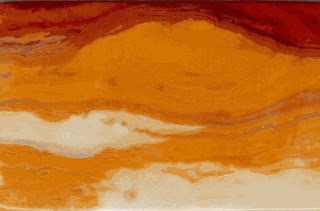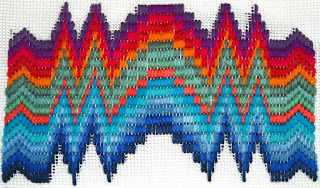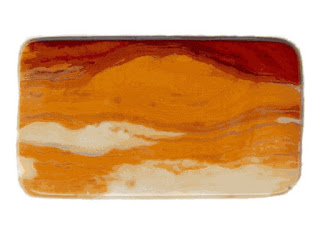 |
| "Early Frost, Olympus Mons" ?? |
Since the dawn of the Space Age we have learned a great deal about other “scapes” — “moonscapes”, “planetscapes” and “spacescapes”. These, whether real or imaginary, can also be part of your artistic vocabulary. Consider this picture of the mighty Martian mountain. Was it photographed during a Voyager flyby, by the Hubble telescope, or by a Mars rover? Or is it an artist’s interpretation based on one of those? If so, is it realistic or abstract? This time we are going to talk a little about geometric and abstract design as it might apply to landscapes.
 |
| Flame stitch for Persian-inspired bargello pillow |
After completing several large projects, I reward myself with time to “play” with some of my favorite kinds of needlework. One of these is bargello. Bargello is the “family name” for geometrically patterned counted-stitch tapestry work. It is usually made with simple upright stitches on canvas or evenweave fabrics. The name comes from the Bargello Museum in Florence, Italy, where many beautiful examples are stored. It is also known as Florentine embroidery, Hungarian point, and flame stitch. Why am I so attracted to bargello? Because it is fun! I love to adapt old patterns for new purposes and to invent new ones. The possible combinations and permutations are endless. They unroll beneath my needles like magic carpets. There is no boredom involved in bargello.
I had just completed a series of pillows and pillow tops in bargello patterns. I decided it would be fun to do some small landscapes based on the bargello patterns combined with other tapestry stitches, each with a whimsical detail done realistically in conventional tent stitch. I call this technique “Bargello Plus”. Below is a picture of my first effort, along with the pillow that inspired it.
 |
| Bargello landscape with matching pillow |
After viewing the pair, our resident computer guru remarked that I had encompassed several centuries of stitchery history and half a globe of geography in one small project. What a wonderful idea! First the tent stitch was invented, probably in the Middle East. Then came a variety of tapestry stitches out of Eastern Europe, possibly due to the elegant embroideries of the Byzantine Empire, including the Hungarian stitch that I used for the sky. These stitches were combined into elaborate patterns in Florentine embroidery when Florence was a major European art center. The patterns, especially variations of flame stitch, came early to the American colonies, where they were used in upholstery. Now here I am in the Rocky Mountains, using all of those techniques. I have added to the timeline by using 20th and 21st Century materials: gridded, quickpoint, and plastic canvas, and acrylic, craft, and novelty yarns.
 |
| "Firs & Feathers," framed needlepoint landscape |
I chose Hungarian stitch for the sky above the forest because its double diagonals echo the sloping profiles of the trees, the subtle slant of the tent stitches, and the strong shape formed by the eagle’s wings. The eagle’s design was charted separately for tent stitch and added to the sky later. Traditional bargello uses closely related hues from the same color family, as you can see in the shading of the evergreen trees and the aspen tress of the next pattern, but you may use any colors that you like. You might want to use the colors of your favorite sports team in a composition, for example. I have done a number of items in the colors of the Denver Broncos, Colorado Avalanche, and Colorado Rapids, as well as school and flag colors. Mild or wild, the patterns are appealing.
| Annake stitching a needlepoint pillowtop |
Both the triangular “evergreen” pattern and the rounded tree designs inspired by our native aspens (seen here in progress) are adapted from 1970’s designs. The aspen “trees” were originally shorter, rounder apple trees. I elongated the designs by changing the lengths and positions of various stitches, and used colors appropriate for our autumn aspens. You can see that I have attached my canvas to a wooden picture frame. It is a square frame of a size that is great for making pillow tops. It is much more comfortable for me to work with a frame like this because the canvas stays stretched taut. When it is completed, the canvas requires very little blocking. There are frames especially made for this purpose, but I am naturally thrifty, and I find this inexpensive frame bought at a thrift shop perfectly suited to my needs.
| "Bearly There,'" framed needlepoint |
Next, I combined the aspen tree pattern with a tent stitch picture of a black bear. The title is “Bearly There”. I chose the bear because his rounded shape fit so nicely into the space created by omitting one of the aspen trees. Other tapestry stitches used in this landscape include brick stitch and Parisian stitch. You will see another of these combination landscapes in a chapter on seascapes. (And others may pop up from time to time.)
If you found the large flame stitch pattern at the beginning of this article a little intimidating, here are two much simpler patterns you may like better. The first is a simple center line pattern done in upright Gobelin over four threads of canvas or fabric. If you place it at the center of your design, you can work the same pattern in other colors both above and below it until you have covered as much area as you desire. Remember that the color sequence below this pattern line is in the reverse order to the one for the stitches above it.
 |
| A simple flame stitch sample |
The second pattern is a simple repeat pattern done in three colors, although you may use as many as you wish. Follow either the yellow or the golden orange line to get the complete pattern. Again, this is upright Gobelin over four threads. If I were doing a larger pattern rather than this border, I would make my center line in the bright red yarn for greatest visibility. Where you do not have room for a complete pattern line, do as much of it as you can.
 |
| Multi-colored flame stitch sample |
While I usually do realistic pictures, every once in a while I venture into the abstract. That was the case with this next project. I had begin a very stylized picture, working free-hand; that is, I was working completely without a pattern. After I had finished a few rows, J. D. looked over my shoulder and suggested I do it as a mirror image. I liked the idea. Indeed, the picture is a double mirror image, since it mirrors from side-to-side, as well as top-to-bottom. The picture is done in upright Gobelin stitch on # 14 needlepoint canvas. This is another stitch from at least as far back as the Renaissance. It is customarily used vertically over four canvas threads, but it can be used horizontally and the thread count over which it is stitched may vary. Because this canvas has a fairly small mesh, I chose to stitch it over four threads, except where the design itself is being modified. Stitches over four strands of this canvas are not very long, especially when the acrylic yarn I used covers the canvas so well. Here is a picture of the project with the pattern shown horizontally.
 |
| Mirrror image Gobelin stitch needlepoint |
Seen this way, it is simply a geometric design. “That’s not a landscape!” you may say. “What is that? A Native American Indian design, perhaps?” But look what happens when the design is rotated 90 degrees and shown vertically. Now it is a stylized representation of the fields and forests, mesas and mountains of western Colorado, with a tranquil lake to reflect it. I don’t usually create a design from Nature that comes this close to the abstract, but this one was fun.
 |
| The same needlepoint rotated 90 degrees - now a landscape! |
About that Martian landscape: it was made right here on Earth — by the Earth itself. This is a piece of cut and polished landscape agate (actual size, about 3" x 1 1/2" or 76mm x 39mm). If you are viewing this post on a device that will rotate the picture, turn it 180 degrees. You will find an entirely different “landscape”.
 |
| Landscape agate cabochon (polished flat) |
If you enjoyed this chapter, try coming up with some composite picture ideas of your own.
 This post by Annake's Garden is licensed under a Creative Commons Attribution-NonCommercial-ShareAlike 3.0 Unported License.
This post by Annake's Garden is licensed under a Creative Commons Attribution-NonCommercial-ShareAlike 3.0 Unported License.